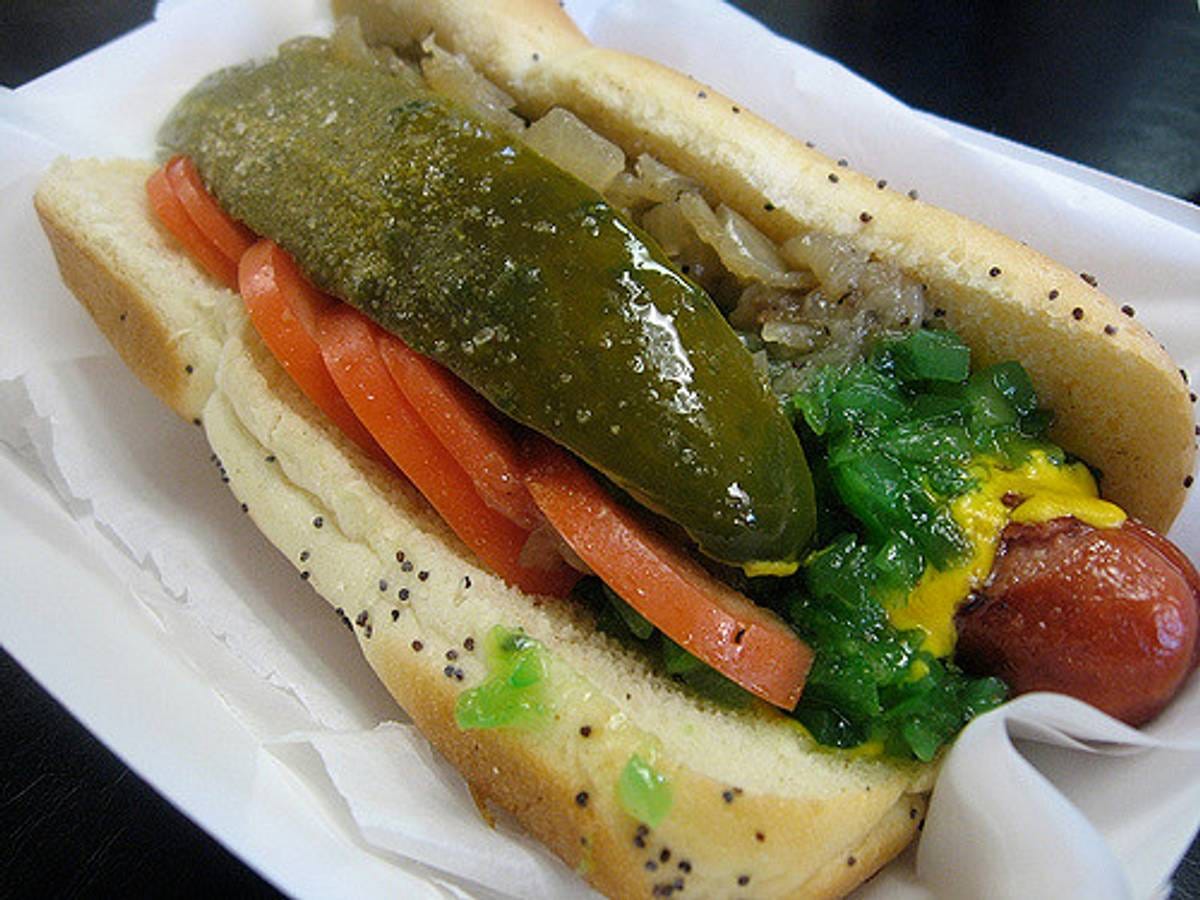It’s almost summer, which means lot’s of cook-outs, which means HOT DOGS. Hot dogs are not known for their “considered” manufacturing, but since we have previously featured Mortadella (basically a giant Italian hot dog), we figured we could sneak in an entry on the Western Hemisphere’s favourite mystery meat. Plus, there’s some really fun stories to share.
Americans eat 7 billion hot dogs every summer. Their predecessor, the sausage, was invented some 1700 years ago in Ancient Rome by Emperor Niro’s chef. The story is too gut-turning to repeat here, but it involves starved-pig intestines and a very creative cook. You can read the brief story here if you are curious. Over the next 1,000 years, sausages spread (or were independently discovered) all over the world from Europe to China. Frankfurt and Vienna have fought over many things (the assassination of Arch Duke Ferdinand, the location of the first coffee shop, etc.) but the last unresolved quarrel between the two cities is who invented the wienerwurst. In a party I am very sad to have missed, Frankfurt celebrated 500 years of the Frankfurter in 1984. In my search for images, all I could find were some very pale looking hot dogs.
The Hit Snack of the World’s Fair
For our purposes, the relevant part of hot dog history starts when German immigrants brought them to North America in the 1860s and began selling them from push carts. A real street meat revolution.
In 1871, Charles Feltman opened the first Coney Island hot dog stand and sold over 3,000 sausages in a milk roll during his first year in operation. The Austrians brought “wieners” to The World’s Fair in Chicago in 1893. Two Chicago butchers, Reichel and Sam Ladany also sold their “Vienna sausages” at the Chicago’s World’s Fair (more on them later). As if the introduction of hot dogs wasn’t enough, the 1893 World’s Fair was also the site of the first ever Ferris Wheel, the first movie theater, the term “midway” and the North American introduction to belly dancing. That is an incredibly impressive amount of amusement innovation in one place.

By 1920 a former employee of Feltman’s, Nathan Handweker, had overtaken his former employer. The Travis Kalaniak of his day, Handweker kept lowering prices until his competitors went out of business. Nathan’s Famous Hot Dogs was selling 75,000 hot dogs a weekend by 1920. The Museum of the City of New York suggests that the Fourth of July hot dog eating contest was started as a test of patriotism. It is now a nationally televised hot dog extravaganza. Fun fact: when I used to fly a lot for work and connect out of La Guardia, two Nathans and a side of fries was my “natural” pre-flight sedative.
Now New York hot dog sales have been distributed all across New York. In 2013, The New York Times reported that Mohammad Mastafa of Astoria, Queens paid the city’s parks department $289,500 a year for the right to operate a single cart at Fifth Avenue and East 62nd Street near the Central Park Zoo. New York hot dog carts produced $450 million annually for the city’s general fund.
The Chicago Connection
While New York is known for its push carts (mainly Sabrett branded hot dogs), it is Chicago that just may be the current hot dog capital of the world. Reichel and Sam Ladany, from the Chicago’s World Fair, have been producing “Vienna Sausages,” distinguished by being all beef, for Kosher reasons, for over 100 years. Vienna Sausages, their company and the main Chicago supplier, have their own Hot Dog Museum in downtown Chicago.
What makes a hot dog Chicago-style? A boiled all-beef frankfurter in a fluffy poppy seed bun that is topped with mustard, relish (the more neon the better), sliced tomato (not diced), a kosher dill pickle spear, chopped onion, spicy sport peppers and a sprinkling of celery salt. I found this history of Chicago kosher meat packing fascinating. They talk about another Chicago all-beef brand (my favourite ever hot dog), the Sinai Kosher. These hot dogs used to be the ones Costco used in their $1.50 hot dog deal.
If you are curious about national hot dog styles, this TikTok series is a great introduction.
Why Do We Call Them Hot Dogs?
There are many unreliable tales of how the hot dog got its name. Most are similar and feature entrepreneurial baseball concessionaires selling sausages that are “red hot.” Dr. Gerald Cohen, Barry Popik, and David Shulman actually studied this and published the definitive academic study on the subject, “Origin of the Term ‘Hot Dog.’” Students at Yale coined the slang in the 1890s. From their study:
The term was based on the popular 19th-century belief that dog meat could turn up in sausages, and this belief had a basis in fact … It was scandalous but true. Some butchers even hired dog killers — young toughs armed with a club who would bash any poor dog they came across and then sell the carcass to the butcher."
Given the impact of the hot dog on popular culture, I was hopeful that there would be a consolidated source of hot dog scholarship. Disappointingly, the Wiener Museum is focused on decorative arts, not wieners. Do not get too alarmed, though, the O’Betty’s Hot Dog Museum has its head in the right place.
The Bun to Dog Disconnect
At the special request of Considered’s editor, I sought to answer the age old question: Why are hot dogs sold in 10-packs and buns in packs of eight? The answer is more thought out than I expected. Once the manufacturing of hot dogs was mechanized (with Oscar Meyer’s invention of the “wiener tunnel”), the standard weight of a hot dog was 1.6oz, or 10 to the pound (lb). As all meat was sold in pounds at the time, a package of hot dogs contained 10. Industrialization had a similar impact on the production of hot dog buns. The standard conveyor belt was wide enough to accommodate a four bun tray, so bakeries had the choice of 8 or 12 buns per package. The current trend is for more plump hot dogs (averaging 3.2oz per dog), which means only 5 per pack to reach a full pound. The only way to win mathematically is to plan for 40 hot dogs, 5 x 8 on the buns, 4 x 10 on the dogs. I am good for three dogs day-of, two the next day. Anyone want to come over for 35 hot dogs?
PS:
Weenie is passé. Glizzy is in. This popular slang term for hot dogs (as featured in such hard-hitting journalistic articles as “Relax Parents, Here’s What Glizzy Means”) is suddenly everywhere. Originating in the DC/Maryland/Virginia area, delightfully abbreviated as the DMV, Glizzy unfortunately has its roots in gun culture. Glizzy is slang for a Glock pistol but the term also includes the extended magazines that became popular in the early 2000s. The jump to the hot dog is less clear, but is likely driven by the visual similarity between the magazine and a hot dog. So if you hear someone rap about having a “glizzy in the stizzy” it probably means they have ammunition in their glove box, but it could also mean they are keeping a hot dog in there.
If you can eat a substantial amount of hot dog in one bite, you get upgraded to Glizzy Gladiator. Here are some famous ones:







